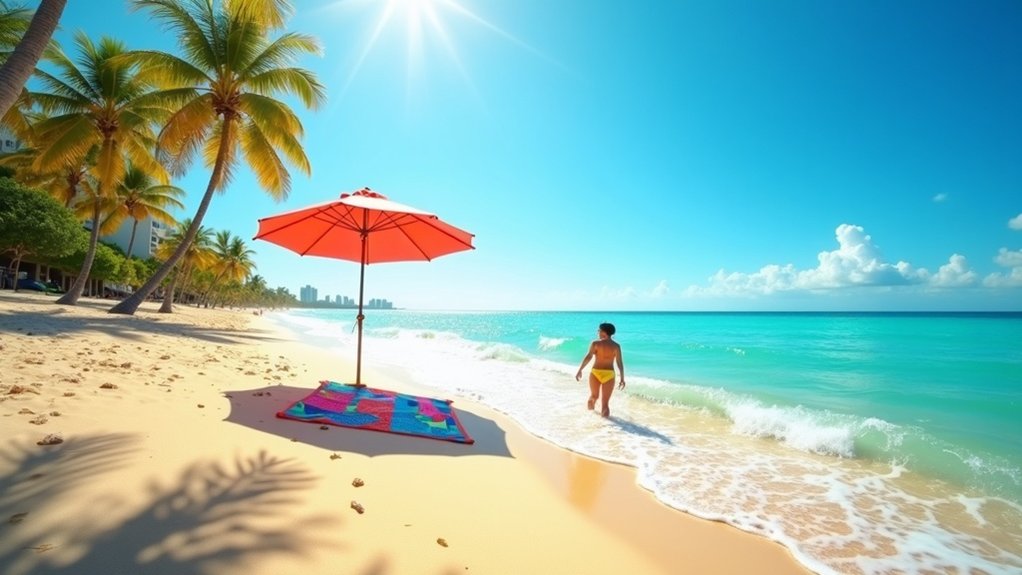Are you curious about whether you can catch a glimpse of the stunning Bahamas from Miami? You’re not alone! Many people wonder about this short distance of just 52 miles between the two locations. It’s intriguing to think that such beauty could be so close, but there’s more to the story. Factors like the curvature of the Earth and weather conditions come into play, making that view a bit trickier than it seems. If you’re eager to learn why the Bahamas remains hidden from sight, keep reading to discover the fascinating reasons behind this travel mystery.
Understanding the Distance: Miami to the Bahamas
When considering the distance between Miami and the Bahamas, particularly the closest island, Bimini, it’s important to understand that 52 miles is more significant than it may initially seem.
Due to the curvature of the Earth, you won’t be able to see the Bahamas from Miami, even on clear days. In ideal conditions, visibility typically extends to about 35 miles, meaning that Bimini remains out of sight.
For travelers looking to make the journey, there are convenient options available. Direct flights to Nassau, the capital of the Bahamas, take approximately 30 minutes to an hour.
Alternatively, a scenic ferry ride to Bimini offers a leisurely two-hour experience on the water.
Regardless of how you choose to travel, the trip to the Bahamas from Miami can be a rewarding escape, providing an opportunity to enjoy the beautiful landscapes and vibrant culture of the islands.
Understanding the distance and travel options can help plan your journey effectively.
The Role of Earth’s Curvature in Visibility
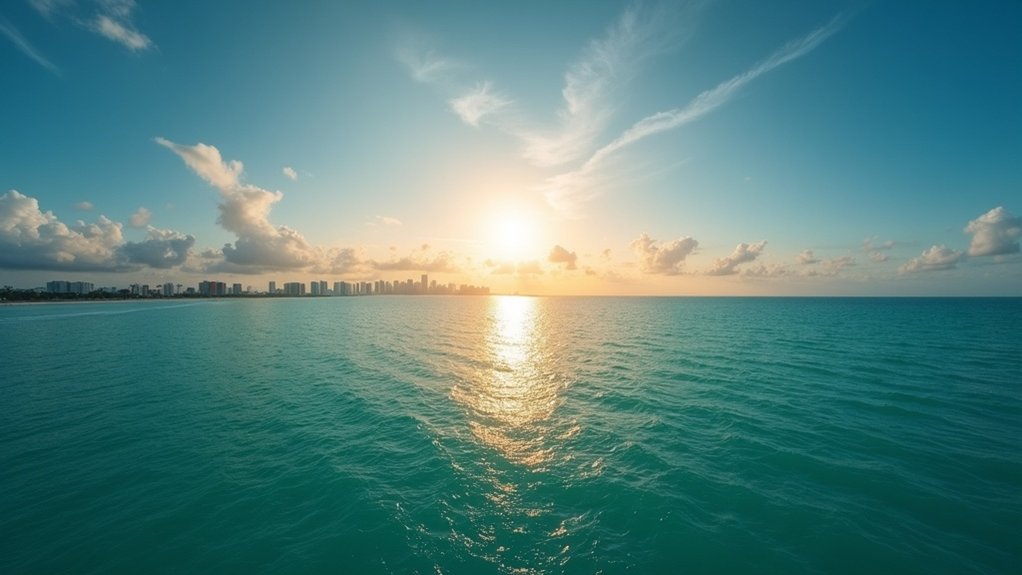
The distance between Miami and the Bahamas is approximately 52 miles. However, the Earth’s curvature significantly impacts what can be seen at that distance. For instance, from the Tibor Hollos Panorama Tower, which stands at 822 feet tall, the maximum visibility is around 35 miles. This limitation arises from the curvature of the Earth; as the height increases, visibility does as well, but it does not negate the effects of the Earth’s shape.
To illustrate this further, consider the following visibility distances based on height:
| Height (feet) | Visibility Distance (miles) |
|---|---|
| 0 | 3 |
| 822 | 35 |
| 1,000 | 40 |
While some may claim to see lights from Bimini on a clear night, the actual land remains obscured by the curvature of the Earth. This example highlights that while elevation can improve visibility, it cannot completely overcome the natural limitations imposed by the planet’s shape. Understanding these principles can help clarify why certain locations may be visible or hidden based on height and distance.
Atmospheric Conditions and Their Impact on Sight

When you look out from Miami, the atmosphere really affects what you can see. Things like humidity, haze, and air pollution can make distant views less clear, which can give the impression that the Bahamas are further away than they actually are.
However, on a clear night, you might catch a glimpse of Bimini’s lights, but that’s only if the conditions cooperate.
This brings to mind how different environmental factors can influence not just our visibility, but also our overall experience of the surroundings.
Atmospheric Clarity Effects
The clarity of the atmosphere significantly affects visibility, particularly over long distances like water. For instance, on clear nights from the Tibor Hollos Panorama Tower, you may be able to see the lights of Bimini, which is located 52 miles away.
However, it’s important to understand that various atmospheric conditions can hinder this visibility. Factors such as high humidity, temperature inversions, and air pollutants can distort what you see, making it difficult to reliably spot distant locations.
In general, the visibility limit for objects on the horizon is around 35 miles. This means that even from an promoted position, you may find it challenging to see the Bahamas. While being at a higher altitude can improve your chances of seeing distant lights, the overall clarity of the atmosphere is the key factor that determines visibility.
When planning to observe distant locations, it’s beneficial to check the weather conditions. Clear skies and lower humidity levels typically lead to better visibility.
Understanding how atmospheric clarity impacts what you can see will help you set realistic expectations for your viewing experiences.
Distance and Visibility Limitations
When considering the view from Miami to the Bahamas, it’s important to understand the distance and visibility limitations that come into play. The Bahamas are located approximately 53 miles from Miami, but under standard atmospheric conditions, visibility is typically limited to about 35 miles. This means that, without assistance, spotting the islands from Miami can be quite challenging.
For instance, if you’re on the top floor of the Tibor Hollos Panorama Tower, which stands at 822 feet, you may be able to see the lights of Bimini on a clear night. However, the actual land remains hidden due to the curvature of the Earth and the significant distance involved.
Additionally, atmospheric conditions such as humidity and haze can further obstruct distant views. Understanding these factors is essential for anyone interested in viewing distant locations.
It’s not just about being at a higher elevation; the clarity of the air plays a crucial role in what you can see. By recognizing these limitations, you can have more realistic expectations about viewing the beautiful islands of the Bahamas from Miami.
Weather Conditions Impact Visibility
Visibility from Miami to the Bahamas is significantly affected by various weather conditions. Understanding these factors can help you gauge how far you might be able to see on any given day.
Humidity plays a crucial role in visibility. High Humidity levels can create a haze that obscures distant objects, making it difficult to see clearly.
Additionally, fog and storms are major contributors to reduced visibility. These weather events can create dense conditions that hinder sightlines dramatically.
On clearer nights, however, visibility can improve notably. Under optimal conditions, it’s possible to see the lights of Bimini, which is approximately 52 miles away.
Yet, the natural curvature of the Earth limits visibility to about 35 miles at best, even from improved viewpoints.
If you’re interested in catching a glimpse of the Bahamas from Miami, it’s important to check the latest weather forecasts.
Atmospheric conditions—such as clarity and moisture—can greatly influence your chances of seeing this beautiful tropical destination.
Calculation Method for Distance and Visibility
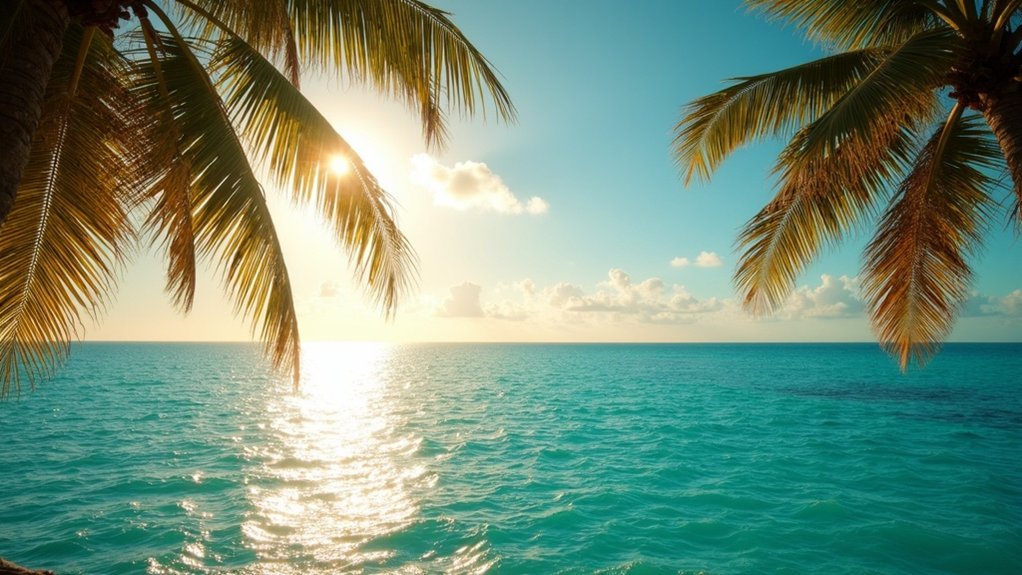
When you visit the Tibor Hollos Panorama Tower, you’ll likely be curious about how far you can see from its height of 822 feet. Under optimal conditions, the distance your eyes can naturally see is about 35 miles.
However, it’s important to note that Bimini, the nearest Bahamian island, is located approximately 53 miles away. This distance exceeds your visibility limit due to the curvature of the Earth.
The Earth’s curvature plays a significant role in what you can observe from high vantage points. As you look out, the horizon is limited by this curvature, making it less likely that you’ll be able to see Bimini’s shores from the tower.
On exceptionally clear nights, you might catch a glimpse of the island’s lights, but the actual land will likely remain out of sight.
While the tower’s height does improve your viewing experience, it doesn’t confirm that distant landmarks will be visible. It’s helpful to manage your expectations when taking in the view, as various factors, including atmospheric conditions and distance, can affect visibility.
High-Elevation Viewpoints in Miami
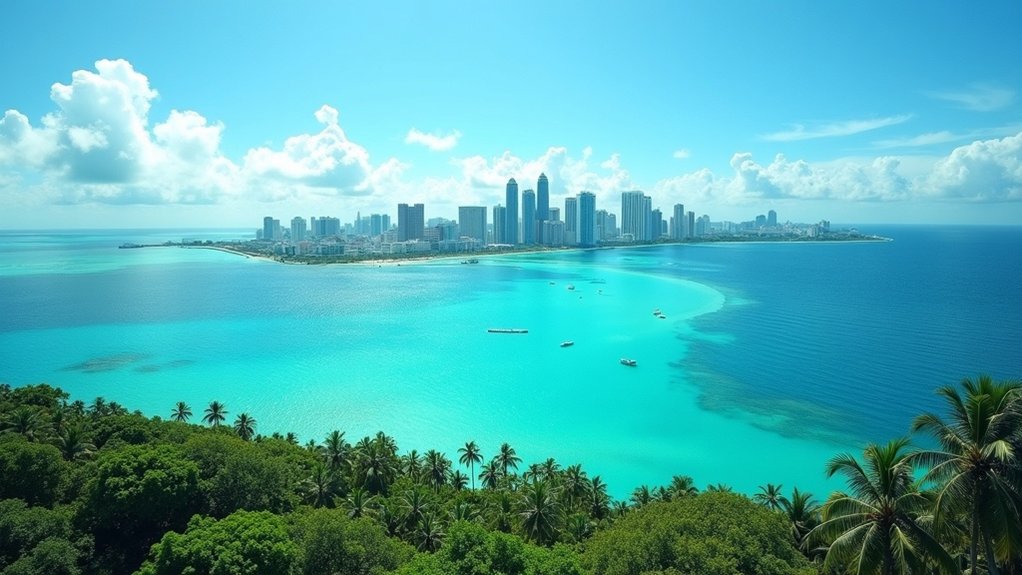
Miami is home to several high-elevation viewpoints that provide stunning vistas of the city and its surroundings. These locations aren’t only great for sightseeing but also for appreciating Miami‘s unique architectural landscape and natural beauty.
Here are some notable high-elevation spots to consider visiting:
- Tibor Hollos Panorama Tower: This tower is set to become Miami’s tallest building at 822 feet. Once completed, it will offer some of the most spectacular views of the city, making it a must-see for anyone interested in urban landscapes.
- Rooftop Bars: Miami’s rooftop bars are popular for their vibrant atmosphere and stunning city skyline views. Enjoying a cocktail at one of these venues allows you to take in both the skyline and the ocean, providing a perfect backdrop for relaxation and socializing.
- Observation Decks: Various observation decks around the city are ideal for capturing breathtaking cityscapes and sunsets. These locations offer a unique perspective of Miami, allowing visitors to appreciate the city’s layout and natural beauty from above.
Looking into these high-elevation viewpoints in Miami will give you a deeper understanding of the city’s charm and architectural diversity. Each location offers a distinct experience, making them valuable destinations for both locals and tourists.
What Can Actually Be Seen From Miami?
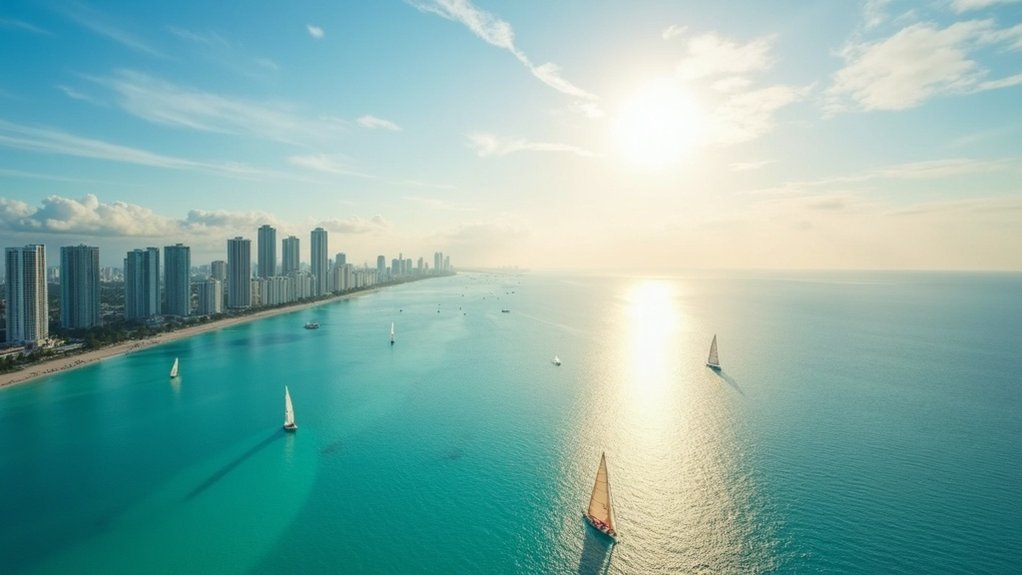
If you’re curious about the views from Miami, it’s essential to understand what you can realistically see from this vibrant city. The Tibor Hollos Panorama Tower provides impressive vantage points, but it’s important to note that the island of Bimini, located 52 miles away, isn’t typically visible. On particularly clear nights, you might catch a faint glimmer of its lights, but such conditions are infrequent.
Scientific research indicates that at an elevation of 822 feet, the maximum visibility range is approximately 35 miles. This means that while you may have a broad perspective of the surrounding area, spotting distant landmarks can be quite challenging.
Factors such as light pollution from the city and varying atmospheric conditions further restrict visibility.
Instead of focusing on distant islands, take the opportunity to appreciate Miami’s stunning skyline, the beautiful beaches, and the vast Atlantic Ocean that stretches before you. The city offers a unique blend of natural beauty and urban vibrancy, making it a remarkable place to enjoy the scenery, even if some landmarks remain out of sight.
The Illusion of Proximity: Water and Sky
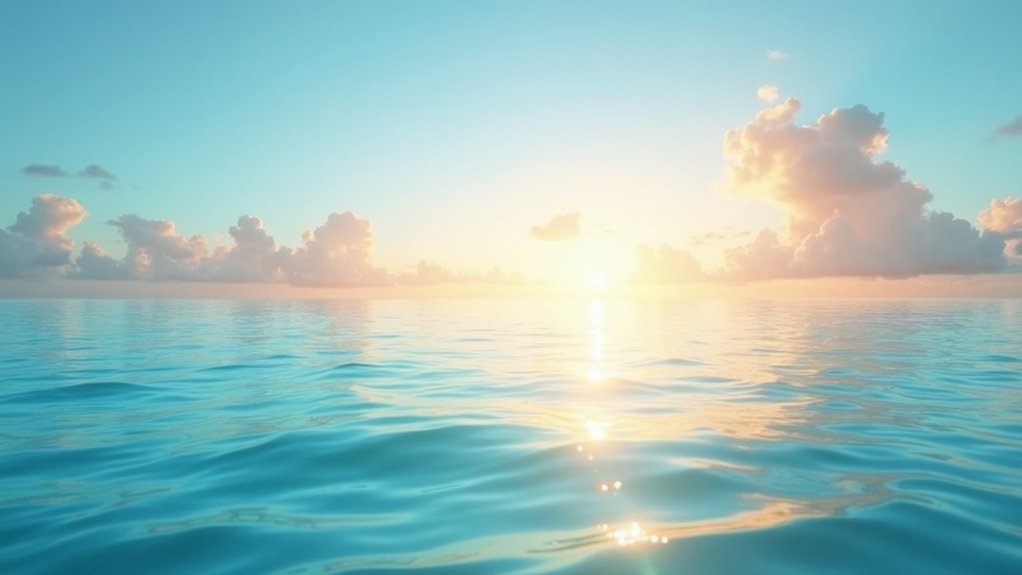
While the sparkling waters of the Atlantic may create an illusion of proximity, the distance between Miami and the Bahamas, specifically Bimini, is approximately 52 miles. This can often lead to misconceptions about how close these islands really are.
Several factors influence visibility over long distances, particularly atmospheric conditions such as humidity and clarity. On clear nights, the horizon can appear deceptively near, making it easy to underestimate the actual distance.
For those seeking a vantage point, the Tibor Hollos Panorama Tower offers a scenic view; however, it doesn’t guarantee a clear sight of Bimini.
It’s also important to understand that the curvature of the Earth limits visibility. From a height of 822 feet, the maximum distance one can see is about 35 miles.
This interplay of water and sky can indeed create a sense of closeness, but it’s essential to recognize the true distance involved when planning a trip to the Bahamas.
Understanding these factors can help manage expectations and improve your travel experience.
Nautical Charts and Horizon Calculators Explained
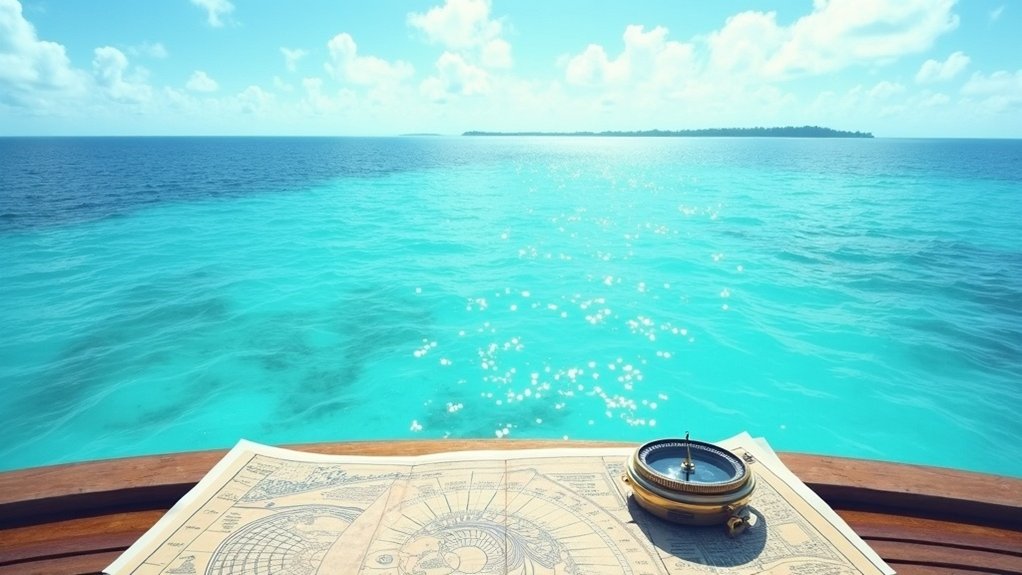
When directing the waters between Miami and the Bahamas, it’s crucial to have a solid understanding of nautical charts and horizon calculators. Nautical charts serve as essential tools for mariners, providing detailed maps that display water depths, navigational hazards, and significant coastal features. These charts are vital for making sure safe passage and avoiding potential dangers while at sea.
Horizon calculators also play a key role in navigation by helping you determine visibility limits based on your height. For instance, if you’re 6 feet tall, your horizon extends roughly 3 miles away. This means that when you’re in Miami, the Bahamas will generally be beyond your line of sight.
However, it’s important to note that atmospheric conditions can influence what you see. Refraction, for example, may allow distant lights, such as those from Bimini, to become visible under certain conditions.
Analyzing the Beauty of the Bahamas From Miami

Traveling from Miami to the Bahamas presents a wonderful opportunity to immerse yourself in the islands’ stunning natural beauty and vibrant culture. The proximity of the Bahamas to Miami means you can reach these picturesque islands with a short flight or a convenient ferry ride.
One of the highlights of visiting the Bahamas is snorkeling in its crystal-clear waters. The underwater ecosystem is rich with colorful marine life, offering a unique experience for both beginners and seasoned snorkelers. The waters around the islands are known for their visibility, making it easy to spot various fish species and coral formations.
Another popular activity is swimming with pigs, particularly in Bimini. These famous swimming pigs have become a beloved attraction, drawing visitors eager to capture memorable moments while interacting with these friendly animals on the beach.
Analyzing Nassau is also a must. The capital city is steeped in history and offers a range of cultural experiences. You can visit historical sites such as Fort Charlotte and the Queen’s Staircase, or wander through bustling local markets to discover Bahamian crafts and cuisine.
Whether you choose a quick day trip or plan a longer stay, the Bahamas promises a variety of unforgettable experiences. It’s important to have your passport ready for a smooth transition between the U.S. and the islands.
With round-trip fares from Fort Lauderdale typically around $100, a visit to the Bahamas can be a budget-friendly getaway.



